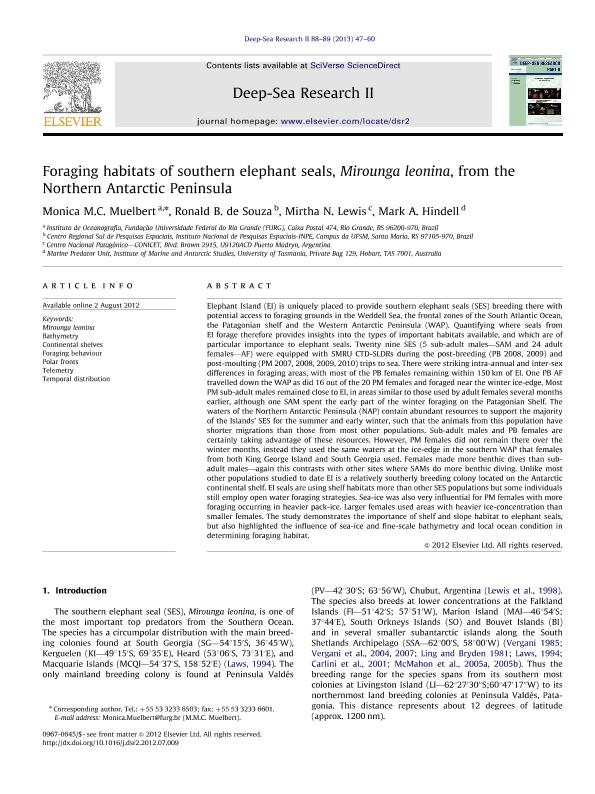Mostrar el registro sencillo del ítem
dc.contributor.author
Muelbert, Monica M. C.
dc.contributor.author
de Souza, Ronald B.
dc.contributor.author
Lewis, Mirtha Noemi

dc.contributor.author
Hindell, Mark A.
dc.date.available
2019-09-09T18:00:14Z
dc.date.issued
2013-04
dc.identifier.citation
Muelbert, Monica M. C.; de Souza, Ronald B.; Lewis, Mirtha Noemi; Hindell, Mark A.; Foraging habitats of southern elephant seals, Mirounga leonina, from the Northern Antarctic Peninsula; Pergamon-Elsevier Science Ltd; Deep Sea Research Part II: Topical Studies in Oceanography; 88-89; 4-2013; 47-60
dc.identifier.issn
0967-0645
dc.identifier.uri
http://hdl.handle.net/11336/83131
dc.description.abstract
Elephant Island (EI) is uniquely placed to provide southern elephant seals (SES) breeding there with potential access to foraging grounds in the Weddell Sea, the frontal zones of the South Atlantic Ocean, the Patagonian shelf and the Western Antarctic Peninsula (WAP). Quantifying where seals from EI forage therefore provides insights into the types of important habitats available, and which are of particular importance to elephant seals. Twenty nine SES (5 sub-adult males-SAM and 24 adult females-AF) were equipped with SMRU CTD-SLDRs during the post-breeding (PB 2008, 2009) and post-moulting (PM 2007, 2008, 2009, 2010) trips to sea. There were striking intra-annual and inter-sex differences in foraging areas, with most of the PB females remaining within 150. km of EI. One PB AF travelled down the WAP as did 16 out of the 20 PM females and foraged near the winter ice-edge. Most PM sub-adult males remained close to EI, in areas similar to those used by adult females several months earlier, although one SAM spent the early part of the winter foraging on the Patagonian Shelf. The waters of the Northern Antarctic Peninsula (NAP) contain abundant resources to support the majority of the Islands' SES for the summer and early winter, such that the animals from this population have shorter migrations than those from most other populations. Sub-adult males and PB females are certainly taking advantage of these resources. However, PM females did not remain there over the winter months, instead they used the same waters at the ice-edge in the southern WAP that females from both King George Island and South Georgia used. Females made more benthic dives than sub-adult males-again this contrasts with other sites where SAMs do more benthic diving. Unlike most other populations studied to date EI is a relatively southerly breeding colony located on the Antarctic continental shelf. EI seals are using shelf habitats more than other SES populations but some individuals still employ open water foraging strategies. Sea-ice was also very influential for PM females with more foraging occurring in heavier pack-ice. Larger females used areas with heavier ice-concentration than smaller females. The study demonstrates the importance of shelf and slope habitat to elephant seals, but also highlighted the influence of sea-ice and fine-scale bathymetry and local ocean condition in determining foraging habitat.
dc.format
application/pdf
dc.language.iso
eng
dc.publisher
Pergamon-Elsevier Science Ltd

dc.rights
info:eu-repo/semantics/openAccess
dc.rights.uri
https://creativecommons.org/licenses/by-nc-nd/2.5/ar/
dc.subject
Bathymetry
dc.subject
Continental Shelves
dc.subject
Foraging Behaviour
dc.subject
Mirounga Leonina
dc.subject
Polar Fronts
dc.subject
Telemetry
dc.subject
Temporal Distribution
dc.subject.classification
Ecología

dc.subject.classification
Ciencias Biológicas

dc.subject.classification
CIENCIAS NATURALES Y EXACTAS

dc.title
Foraging habitats of southern elephant seals, Mirounga leonina, from the Northern Antarctic Peninsula
dc.type
info:eu-repo/semantics/article
dc.type
info:ar-repo/semantics/artículo
dc.type
info:eu-repo/semantics/publishedVersion
dc.date.updated
2019-06-03T19:17:52Z
dc.journal.volume
88-89
dc.journal.pagination
47-60
dc.journal.pais
Estados Unidos

dc.description.fil
Fil: Muelbert, Monica M. C.. Fundação Universidade Federal do Rio Grande; Brasil
dc.description.fil
Fil: de Souza, Ronald B.. Centro de Previsao de Tempo e Estudos Climáticos. Instituto Nacional de Pesquisas Espaciais; Brasil
dc.description.fil
Fil: Lewis, Mirtha Noemi. Consejo Nacional de Investigaciones Científicas y Técnicas. Centro Científico Tecnológico Conicet - Centro Nacional Patagónico; Argentina
dc.description.fil
Fil: Hindell, Mark A.. University of Tasmania; Australia
dc.journal.title
Deep Sea Research Part II: Topical Studies in Oceanography

dc.relation.alternativeid
info:eu-repo/semantics/altIdentifier/url/https://www.sciencedirect.com/science/article/pii/S0967064512000951
dc.relation.alternativeid
info:eu-repo/semantics/altIdentifier/doi/https://doi.org/10.1016/j.dsr2.2012.07.009
Archivos asociados
